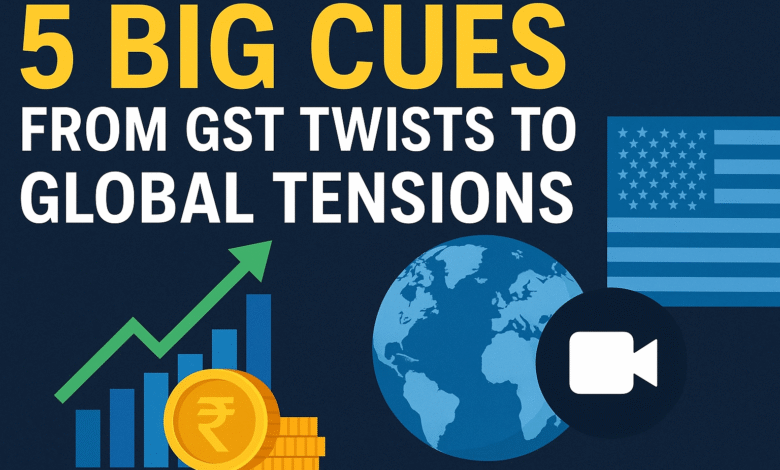Markets on Edge: 5 Big Cues From GST Twists to Global Tensions

Markets on Edge: Track the big seven drivers this week—GST tweaks, geopolitics, and tariffs. The market feels heavy with data, and every headline seems to move the needle.
Geopolitics, especially, has taken center stage. In fact, if you made a list of moments when politics shaped market trends, the last 7–10 days would rank right near the top.
India joined Russia and China at the SCO meet. Prime Minister Narendra Modi’s symbolic handshake with Xi Jinping made waves. Then Donald Trump jumped in with sharp social media comments about the three leaders. Add rising tariff worries, and suddenly, the global order looks shaky. Investors can feel the tension.
Table of Contents
Bloomberg notes that this symbolism comes at a critical time. Indian markets are already underperforming. The Nifty is down 1% over the past three months. Markets on Edge: Compare that to the MSCI Emerging Markets Index—up nearly 8% in the same stretch. Even Shanghai Composite gained more than 1%.

Look at the bigger picture. The Nifty 50 is up just 4.6% this year. The MSCI EM Index? A strong 19% rally. The gap is clear. The market is anxious. And much of that anxiety circles back to one question—what will Trump do next?
So far, even strong positives haven’t done the trick. The new GST rates. The revamp of the tax structure. Even a sharp 7.8% GDP growth print for Q1. All big headlines. Yet, none of them could lift investor mood for long. The excitement faded quickly.
Now the focus shifts again. Another week. Another wave of data. And investors have their eyes on the 5 big cues that could shape market moves this time.-
FII outflow continue – What drive it?
Foreign investors are still pulling money out. The selling spree goes on. In the cash market alone, FIIs sold equities worth ₹5,666 crore.
That pushes the total FPI outflow in 2025 to ₹1,76,606 crore. Compare that with last year’s ₹1,21,210 crore. Much higher. Much sharper.
But here’s the twist. While FIIs are exiting, domestic investors (DIIs) are buying like never before. Their record inflows have kept the market from sinking.
Dr. V.K. Vijayakumar, Chief Investment Strategist at Geojit Investments, put it simply: massive DII buying is giving FPIs a perfect exit. They book profits at high valuations in India and move funds to cheaper markets—China, Hong Kong, South Korea. Even the GST reforms couldn’t slow them down. FPIs have sold every single day of September so far.
And that’s not all. High valuations aren’t the only headache. Trump is. His tariff moves—and the fear of what comes next—hang heavy on the market. Some even worry that Indian IT services could be hit by US tariffs.
The result? A market on edge. Investors nervous. Sentiment fragile.
Also Read:Teacher Vs AI: Teachers Taught Us How to Learn, AI Teaches Us How to Ask
India-China tie – Still shifting ground
The recent SCO meeting lit a spark. Hopes rose that India and China might finally move towards better ties. For two giant economies and close neighbours, cooperation is always win-win. But right now, India could gain a little more.
Look at the numbers. India exported $14.2 billion to China in FY25. But imports? A massive $113.5 billion. The trade gap is wide. Too wide.
Jasmine Duan, senior investment strategist at RBC Wealth Management, told Bloomberg that improved ties could lift India’s market more strongly. Why? Because India is the one facing a 50% tariff hike.
For Chinese stocks, the effect would be indirect. Marginal at best. Nothing that can spark a major rally.
There’s another angle too. Valuations. Chinese and Hong Kong indices are trading at nearly half the price of Indian markets. For foreign investors, that makes them look like bargains. Attractive. Cheaper. Easier to buy.
So yes, India-China ties may be thawing. But the investment story? That’s still tilted towards China—for now. :LINK
US tariff worry not going away
The tariff talk is back. The US President said trade negotiations with India are “going well.” Sounds positive. But markets are not fully convinced.
India’s Commerce Minister, Piyush Goyal, tried to calm nerves. In his words to ANI: “No need to panic. Let the negotiations play out.”
Analysts agree that clarity could help. Ajit Mishra, SVP of Research at Religare Broking, pointed out that any concrete update on the India-US trade deal would lift sentiment.
For now, though, it’s still just words. And markets don’t like waiting too long.
All eye on data this week
This week is heavy. Data-heavy. Both at home and abroad.
On September 12, the August inflation print will grab all the attention. Especially now, after the GST rate changes. Everyone wants to see how prices react.
But that’s not the only number on the radar. Bank credit growth. Deposit growth. Forex reserves. All of them matter. All of them will be tracked closely.
Banks have been underperforming lately. That makes these numbers even more critical. A miss could shake sentiment further. A surprise on the upside could bring some relief.
For traders, it’s simple. This week, data is the driver.
Inflation number on Sept 12
Circle the date. September 12. That’s when the inflation data comes in. And it’s not just another number. It’s the one that could set the tone ahead of the RBI policy meet in October.
Why so important? Because the GST rate revamp is expected to lift consumption. More spending. More demand. And the RBI will be watching closely.
Globally, the Fed has already shown signs of easing. If India follows, rate cuts could be on the table. But here’s the catch—the inflation trend will decide how far the RBI can go.
So for now, all eyes on that print. It could be the trigger. Or the brake.
So what next?
Markets are on edge. GST reforms promise. Geopolitics distracts. FIIs sell. DIIs fight back. Tariff clouds hover. Data waits to drop.
It’s a mix of hope and worry. Fear and greed. Numbers and narratives.
For investors, the message is simple—stay alert. These five cues will shape the week. And in a market that twitches at every headline, missing a beat is not an option.

